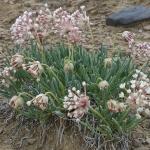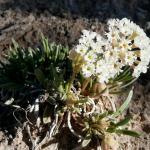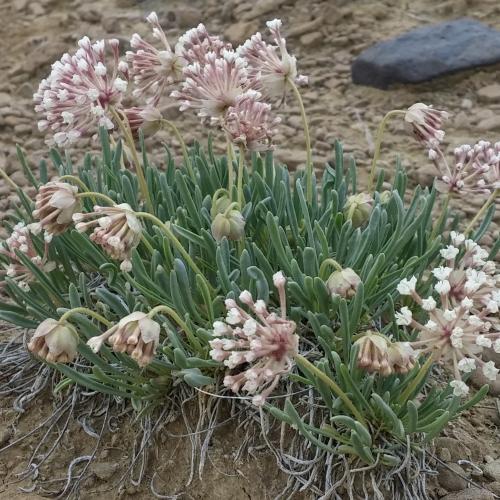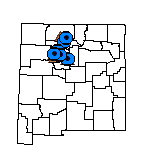Abronia bigelovii (Galisteo Sand Verbena)
NONE
| USFWS | State of NM | USFS | BLM | Navajo Nation | State Rank | Global Rank | R-E-D Code | NMRPTC Status | Strategy Status |
|---|---|---|---|---|---|---|---|---|---|
| SEN | SEN | S3 | G3 | 1-1-3 | R | SS |
| Overall Conservation Status | Documented Threats | Actions Needed |
|---|---|---|
| UNDER CONSERVED | Mining and quarrying |
Status surveys outside the White Mesa area. Trend monitoring, seed banking |
Dwarf, tufted, perennial, semi-succulent, grayish-green herb with leaves clustered on very short thick branches that remain near the ground; leaves linear to narrowly oblong, 1.5-5 cm long, 1.5-3 mm wide, smooth or with a few minute hairs; flowering stalks erect to spreading, 3-12 cm long, terminating in a head of 20-30 flowers; heads 2-3 cm broad, surrounded by pale, papery, ovate bracts; flowers trumpet-shaped, glandular, 1.5-2 cm long, the tube pinkish, the lobes whitish; fruit stiffly papery, about 8 mm long, with 4-5 ridges, containing within, a single black "seed" (technically the true fruit). Flowers May to October.
Abronia fragrans and A. elliptica, both with whitish trumpet-shaped flowers, grow in the same region. These species, however, do not form dense low tufts, and their leaves have ovate or broadly oblong blades. Abronia nana, from northern Arizona, southwestern Colorado, Utah, Nevada, and southern California forms low tufts, but the blades are differentiated into a distinct petiole and a broader, oval to elliptic blade.
New Mexico, Sandoval, Santa Fe, San Juan, and Rio Arriba counties. Apache County, AZ.
Hills and ridges of gypsum in the Todilto Formation, 1,750-2,250 m (5,700-7,400 ft).
Populations are usually small and are restricted to gypsum or strongly gypseous soils derived from gypsum outcrops. Plants are conspicuous on the otherwise rather barren gypsum. Although locally rather common, they do not form dense populations.
The species occurs in several populations. Extensive disturbance to its habitat, such as recreational vehicle use of gypseous hills or mining of gypsum outcrops, may seriously threaten some local populations.
*New Mexico Native Plants Protection Advisory Committee. 1984. A handbook of rare and endemic plants of New Mexico. University of New Mexico Press, Albuquerque.
Standley, P.C. 1918. Allioniaceae. North American Flora 21(3):171-254.
Roth, D. 2016. Status Survey for Gypsum Townsend's Aster (Townsendia gypsophila), Sivinski's Scorpionweed (Phacelia sivinskii), Todilto Stickleaf (Mentzelia todiltoensis), and Tufted Sand Verbena (Abronia bigelovii) on Zia Pueblo Lands in Sandoval County, New Mexico. Unpublished report prepared by EMNRD-Forestry Division, Santa Fe, NM for the U.S. Fish & Wildlife Service, Region 2, Albuquerque, NM. 29 pp.
Roth, D., and R. Sivinski. 2015. Survey and status report for rare gypsophilic plants in the Ojito/White Mesa area of Sandoval County, New Mexico. Unpublished report prepared by the NM Energy, Minerals, and Natural Resources Department, Forestry Division, for the BLM Rio Puerco Field Office, Albuquerque, NM.
For distribution maps and more information, visit Natural Heritage New Mexico









